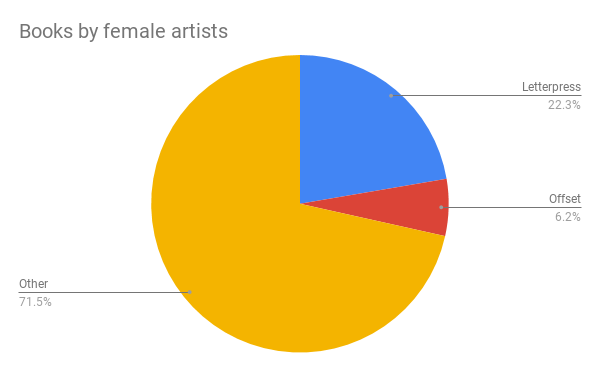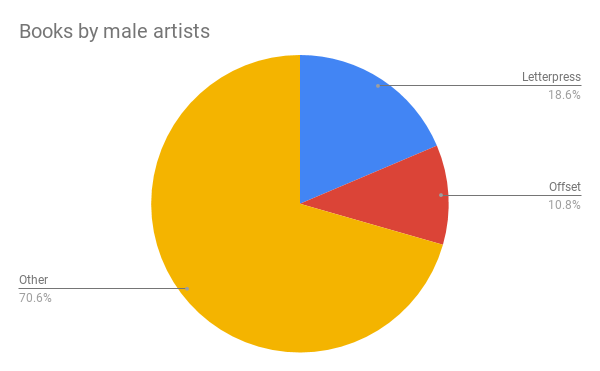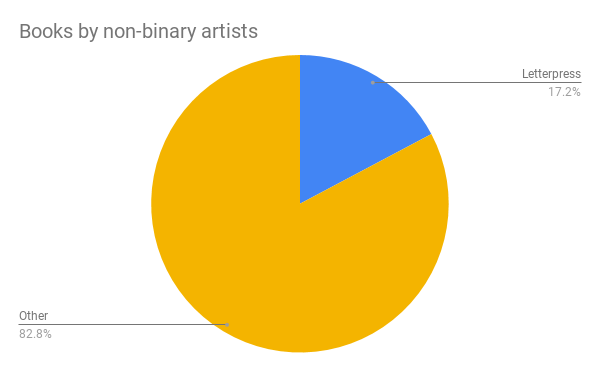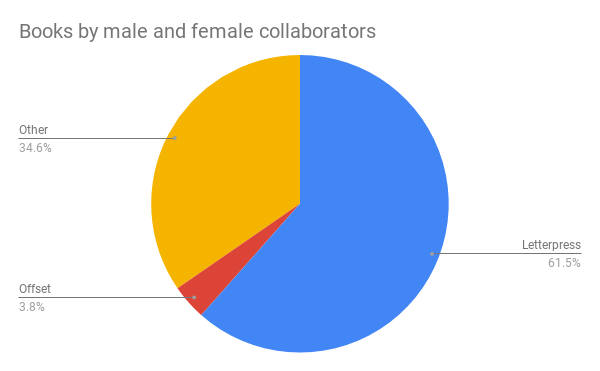In my previous blog post, I introduced an ongoing research project about gender and print production in artists' books. In this post, I’ll share the early results – some expected, some surprising, and some that call for additional research. (Before I dive in, let me begin with the caveat that my sample sizes are still very small and I will continue to work through many more data points for a longer analysis.)
I began by questioning whether letterpress was indeed a women-dominated area of book art (in relative terms, since around 75% of book artists are women). Having looked at books from a university collection, a dealer, a journal and a self-reported survey, I can definitively say: yes – but in relative terms, not by a huge degree. 22% of artists’ books by women were letterpress printed compared to 19% by men. Letterpress accounted for 17% of books by non-binary artists (but a sample size of only two artists makes this data inconclusive).
I also wanted to find out if offset printing was dominated by male artists. Again, yes. 11% of books by men were offset printed compared to only 6% by women. The discrepancy here is significantly larger than with letterpress – men were 74% more likely to print offset, whereas women were only 20% more likely to print letterpress than men.



So, what results weren’t expected? It turns out letterpress is overrepresented in collaborations between men and women. Based off the individual numbers, letterpress should account for around 20% of mixed-gender collaborations. Instead, a whopping 62% of collaborative books are letterpress printed. This is even more remarkable given the physical constraints of a letterpress collaboration versus processes that more easily accommodate virtual collaboration online. So what does this mean? Though possible that letterpress is either better suited for executing collaborations, or somehow better at inspiring them, I think this shows that artists choose to collaborate as a means of accessing a press. Are these collaborations the artistic equivalent of helping your friends move because you own a pick-up truck?

Access to offset printing seems to require a different strategy. Offset-printed books were much more likely to be published by an organization than those by other methods. It’s difficult to assess this factor clearly since publishers are also more likely to place books in collections and send them for review, but that only illustrates the importance of these organizations in the field. For example, 80% of the offset-printed “books reviewed” from [my current sample of] The Journal of Artists’ Books (JAB) were published by or at an organization. If the 74% disparity in adoption of offset reflects a disparity in access (as suggested by the preponderance of publishers), then this number is quite problematic.
The outsized influence of relatively few institutions (for publishing, collecting, reviewing, etc.) is an expected feature of such a young, small field. It requires a researcher to approach each question from multiple angles and look for causes and connections in unexpected places. Since I’ve only just begun to scratch the surface, and I hope to encourage others to look at the influence of social factors on the production and reception of artists’ books, I will close by examining some some of these methodological contingencies.
It is critical to understand the interrelation of technologies. I found that the University of Missouri’s collection represents letterpress much more than offset, which seems peculiar since letterpress is not a strength of the art department. However, hand paper-making is particularly strong at MU. By fulfilling their mandate to support the curriculum – in this case emphasizing books with handmade paper – MU special collections has built an impressive showcase of letterpress printing as well.
A related point is the need to understand how organizations’ policies shape the visible tip of the artists’ book iceberg (previously a field, apologies for the mixed metaphor). Collections and dealers show only what is bought, not what is made. JAB focuses on editions, and Printed Matter, for example, requires a minimum edition size of 100. I couldn’t have done the research I’ve presented thus far without catalogues, but the results of the survey I created offer a much richer view of the discipline, including the visibility of non-binary gender, and the inspiring, dizzying numbers of books created (but probably not all sold) by some practitioners. It is clear that artist’s books demand examination from various perspectives all along the communications circuit.
I am still compiling data, so please do fill out my survey if you haven’t already. Thank you to everyone one who has.
Levi Sherman is an interdisciplinary artist and designer in Columbia, Missouri.

